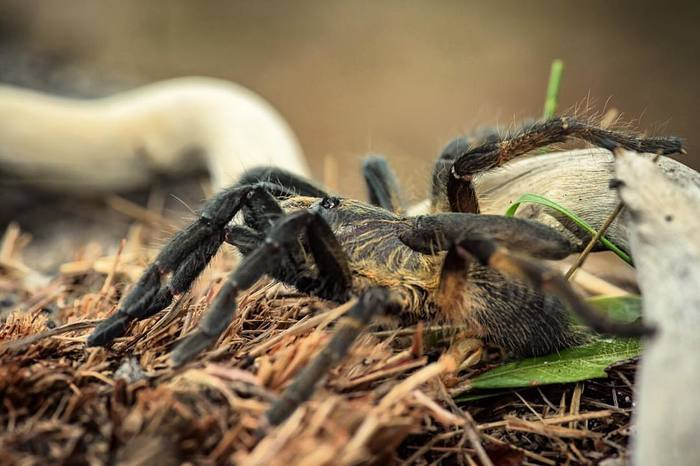Rear Horned Baboon Tarantula
Ceratogyrus darlingi
Care Sheet
Rear-horned Baboon Tarantula Care
Ceratogyrus darlingi Care Guide
The Rear Horned Baboon Tarantula
Revision Date: March 2025
Introduction
Ceratogyrus darlingi, commonly known as the Rear Horned Baboon Tarantula, is a fascinating Old World fossorial species native to Botswana, Zimbabwe, Mozambique, and South Africa. This species is well-known for its distinctive backward-curved foveal horn, a unique feature among tarantulas. It is an obligate burrower, meaning it spends most of its time hidden in deep burrows, only emerging at night or during feeding.
Despite its often-hidden nature, C. darlingi is a fast-growing, hardy species with an impressive feeding response and intricate webbing behavior. It is not recommended for beginners due to its defensive nature, potent venom, and rapid speed. However, for experienced keepers looking to add an iconic African fossorial species to their collection, this tarantula is an excellent choice.
Quick Species Snapshot
Scientific Name: Ceratogyrus darlingi
Common Name: Rear Horned Baboon Tarantula
Type: Fossorial (Obligate Burrower)
Category: Old World
Native Range: Botswana, Zimbabwe, Mozambique, South Africa
Size: Up to 5” (13 cm) DLS
Growth Rate: Medium to Fast
Life Expectancy: Females 13–15 years / Males 2–4 years
Experience Level: Intermediate
Urticating Hairs: No
Venom Potency: Strong (painful bite, symptoms include muscle cramping, nausea, and headaches)
Taxonomy, Etymology & Natural Environment
Ceratogyrus darlingi, commonly known as the Rear-Horned Baboon Tarantula, is a striking Old World species belonging to the Harpactirinae subfamily of tarantulas, which are native to Africa. Like other members of the Ceratogyrus genus, this species is known for the distinctive horn-like protrusion on its carapace, though in C. darlingi, the horn is typically more pronounced and positioned toward the back of the carapace, giving it its common name. Described in 1897 by Reginald Innes Pocock, this species is highly sought after in the tarantula hobby due to its impressive burrowing behavior, unique appearance, and bold temperament.
The genus name Ceratogyrus comes from the Greek words "keratos", meaning "horned," and "gyros", meaning "round" or "curved," referring to the distinctive carapace protrusions found in species of this genus. The species name darlingi is a reference to its type locality in Matabeleland, Zimbabwe, and is likely named after a British colonial figure associated with the region at the time of its discovery.
Natural Range & Habitat
Ceratogyrus darlingi is native to southern Africa, primarily found in Zimbabwe, Botswana, Namibia, and parts of South Africa. It inhabits dry, open savannas, scrublands, and semi-arid regions, where it thrives in deep burrows excavated in sandy or compacted soil. Like other African baboon tarantulas, C. darlingi is a true fossorial species, spending the majority of its life underground, emerging primarily at night to hunt for prey.
The purpose of the foveal horn found in C. darlingi and other Ceratogyrus species remains a subject of debate. Some researchers suggest it may reinforce the carapace, assist in thermoregulation, or serve a sensory function, though its exact evolutionary advantage is still uncertain. Regardless of its purpose, the horn makes C. darlingi one of the most visually distinctive African tarantulas.
Behavior & Temperament
Like many Old World tarantulas, C. darlingi is fast, defensive, and highly reactive to disturbances. While not quite as aggressive as some Hysterocrates or Pelinobius species, it will not hesitate to stand its ground, display a threat posture, or deliver a bite if provoked. Unlike New World tarantulas, C. darlingi does not have urticating hairs, relying instead on its speed, fangs, and venom for defense.
Bites from C. darlingi are not considered medically significant, but they can be painful, leading to localized swelling, muscle cramping, and discomfort for several hours. Due to its quick movements, defensive nature, and potent venom, this species is best suited for experienced keepers who are comfortable managing Old World tarantulas.
Adaptability & Captive Care
Ceratogyrus darlingi is a hardy and resilient species that thrives in semi-arid enclosures with deep substrate for burrowing. Unlike tropical tarantulas, it does not require high humidity levels, and excessive moisture can be harmful. Instead, it prefers a dry setup with occasional misting or a water dish for hydration.
Thanks to its unique horned carapace, active burrowing behavior, and bold personality, Ceratogyrus darlingi has become a favorite among experienced tarantula keepers. However, its speed, defensiveness, and potent venom make it a species that demands respect and careful husbandry. Properly housed and maintained, C. darlingi is a fascinating and rewarding species to observe in captivity.
Housing & Substrate – Fossorial Setup
Check out Tarantula Cribs for the BEST fossorial tarantula enclosures. Use code TTC10 to save 10%!
Spiderlings
Enclosure Size: OG Sling Crib, 3” Tarantula Cube, 4” Tarantula Cube
Substrate: Fill at least 2/3 of the enclosure with Terra Aranea by The Bio Dude.
Humidity: Keep the substrate slightly damp, but not swampy. Provide a tiny water dish if space allows or drip water onto webbing weekly.
Juveniles
Enclosure Size: Crib 360-4” Fossorial, 5” Hex Crib, 6” Tarantula Cube, 8” Cube
Substrate: Fill ½ to ¾ of the enclosure with Terra Aranea by The Bio Dude to support deep burrowing.
Humidity: Let part of the substrate dry out while keeping one corner slightly damp by overflowing the water dish occasionally.
Additional Features: Cork bark or dried leaves as web anchors.
Adults
Enclosure Size: 8” Hex Crib, Crib 360-8” Fossorial, 12” Tarantula Cube, 18” Tarantula Cube
Substrate: Fill at least ½–¾ of the enclosure with Terra Aranea by The Bio Dude.
Additional Features: A deep burrow setup is essential. I like to add some branches or plants so they can web up around their burrow entrance as well.
Tarantula Cribs offers the best enclosures—use code TTC10 for 10% off.
Temperature & Humidity
Temperature: 70–78°F (21–26°C)
Humidity: 50–60%
Ventilation: Ensure good airflow to prevent stale conditions.
Water Dish: Keep one filled and overflow occasionally to maintain a moisture gradient.
Feeding Schedule
Spiderlings
Frequency:
Feed twice a week.Prey:
Offer small prey such as flightless fruit flies, confused flour beetles, or pre-killed tiny crickets/roach nymphs. Remove any uneaten prey after 24 hours. increase the size of the prey as the spider grows. Prekill any prey that is over 2/3 the size of the sling. For more detailed information on feeding spiderlings, watch this video: How To Feed Spiderlings & Scorplings (Baby Tarantulas & Scorpions)Post-Molt:
Wait 24–48 hours after a molt before feeding. Ensure that the tarantula’s fangs are solid black and its exoskeleton is not soft or shiny.
Juveniles
Frequency:
Feed every 7–10 days.Prey:
Provide 2–3 small to medium crickets or a medium Dubia roach.Feeding Guidelines:
If the abdomen is thinner than the widest part of the carapace, feed more prey more often.
If the abdomen is wider than the carapace, feed less prey, less often.
This strategy helps prevent obesity, which can lead to molting complications or increase the risk of an abdomen rupture from even a small fall.
Post-Molt:
Wait 3–7 days after a molt before feeding, ensuring that the tarantula’s fangs are solid black and its exoskeleton is fully hardened.
Adults
Frequency:
Feed every 2–3 weeks (or as needed).Prey:
Offer 4–5 large crickets or one large Dubia roach.Feeding Guidelines:
If the abdomen is thinner than the carapace’s widest part, increase feeding frequency.
If the abdomen is wider than the carapace, reduce feeding frequency.
This is crucial to avoid obesity, which can interfere with proper molting or cause dangerous issues such as an abdomen rupture.
Post-Molt:
Wait 5–10 days after a molt before feeding, ensuring that the tarantula’s fangs are solid black and its exoskeleton is fully hardened.
Breeding Ceratogyrus darlingi in Captivity
Breeding Ceratogyrus darlingi (Rear-Horned Baboon Tarantula) can be both rewarding and challenging due to their fast growth rate, defensive nature, and unique breeding behaviors. This species is known for producing large egg sacs, making captive breeding an excellent way to maintain a healthy population in the hobby while ensuring that wild populations remain protected.
Sexual Maturity & Pairing
Male Maturity: Males mature quickly, usually within 2–3 years, developing tibial hooks and enlarged pedipalps for sperm transfer.
Female Maturity: Females take 3–4 years to reach reproductive maturity, which is relatively fast compared to other species.
Pre-Pairing Preparation: We should ensure the female is well-fed before pairing to minimize defensive responses. Increasing humidity slightly before introduction may encourage receptivity.
Mating Process
Introduce the male at night, when both tarantulas are more active.
The male will drum on the substrate or webbing to signal his presence.
If receptive, the female will either drum back or remain still, allowing the male to lift her with his tibial hooks and insert his emboli.
Once mating is complete, the male should be removed immediately, as C. darlingi females are highly defensive and may attack post-mating.
Egg Sac Production
If fertilized, the female will produce an egg sac 4–6 weeks after mating, which is faster than many species.
Maintain temperatures around 75–82°F (24–28°C) with humidity levels of 60–70%, ensuring proper ventilation to prevent mold.
The egg sac typically contains 100–300 eggs, making it one of the more productive fossorial species.
Egg Sac Handling (Optional)
Some breeders choose to pull the egg sac after 30–40 days for artificial incubation.
If left with the mother, 1st instar spiderlings will emerge in 6–8 weeks, molting into 2nd instar within 3–4 weeks.
Raising Spiderlings
C. darlingi spiderlings are fast-growing and hardy, making them relatively easy to raise.
Provide deep substrate for burrowing, along with a secure hide to encourage natural behaviors.
Feed them pinhead crickets, flightless fruit flies, or small roaches every 3–4 days.
Challenges & Considerations
Female defensiveness: C. darlingi females are highly defensive, and males should always be removed immediately after mating.
Fast growth rate: This species matures quickly, which is beneficial for breeding projects but requires timely pairings before males expire.
Male lifespan: Males typically do not live beyond a year after maturing, so breeding attempts should be made as soon as possible.
With their impressive horned carapace and bold personality, Ceratogyrus darlingi is a fascinating species to keep and breed. By prioritizing captive breeding efforts, we can help preserve wild populations while ensuring that healthy, well-acclimated individuals remain available in the hobby. Every successful breeding project strengthens the future of this unique tarantula and contributes to sustainable keeping practices.
Final Thoughts
Ceratogyrus darlingi is an incredibly unique fossorial tarantula, easily recognized by its backward-curving foveal horn. While it may spend much of its time underground, it makes up for it with an explosive feeding response and intricate webbing behavior. This species is best suited for experienced keepers, given its defensive temperament and potent venom.
Compared to other African fossorial tarantulas, C. darlingi is slightly more secretive than Pterinochilus spp. but less defensive than Hysterocrates gigas. If you’re looking for a hardy, low-maintenance fossorial species with a distinct look, C. darlingi is an excellent choice.
Additional Recommendations (a small commision comes back to help support the Tarantula Collective):
For enclosures, consider Tarantula Cribs (affiliate code TTC10 for a 10% discount), and use Terra Aranea by The Bio Dude for substrate and check all their other bio active supplies. For tarantulas, check out Spider Shoppe (use code TTC10 for 10% off), and visit the Dealer & Discounts section on my website for a curated list of recommended dealers and discount codes.
TOP 5 Fossorial Tarantulas
Spiders Underground
This is one of the MOST REQUESTED videos over the past few years. I have avoided making it until now, because fossorial tarantulas are hard to film. Especially since I don't want to dig them up just to make a video. But I think we have figured out a solution to filming these spiders that live underground.
TOP 10 Budget Tarantulas
Are you looking to add some tarantulas but you are on a budget? Want some inexpensive spiders to add to your collection? Or maybe you just want to get the most BANG for your BUCK! This Top 10 List of Budget tarantulas counts down the cheapest, or least expensive tarantulas in the hobby....well at least here in the US.


















